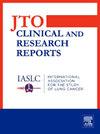Lung Cancer Screening Eligibility, Uptake, and Adherence in Puerto Rico, 2022
IF 3.5
Q2 ONCOLOGY
引用次数: 0
Abstract
Importance
Lung cancer screening (LCS) with yearly low-dose computed tomography reduces lung cancer mortality, but uptake remains low. Puerto Rico, a U.S. territory, faces significant barriers to LCS implementation, but data on LCS eligibility and use are limited.
Objective
This study aimed to estimate the number of individuals eligible for LCS in Puerto Rico and assess the prevalence of LCS use and up-to-date status compared with U.S. Hispanic and non-Hispanic populations.
Design, Setting, and Participants
This cross-sectional study analyzed data from the 2022 Behavioral Risk Factor Surveillance System, a population-based telephone survey. Adults eligible for LCS per 2021 U.S. Preventive Services Task Force guidelines (aged 50–80 years, ≥20 pack-year smoking history, current or recent smokers) from Puerto Rico and the United States were included.
Exposures
Participants were categorized into three groups: Puerto Rico residents, U.S. Hispanic, and U.S. non-Hispanic populations.
Primary Outcomes and Measures
The primary outcomes and measures were self-reported receipt of initial LCS (ever had chest CT for screening) and being up to date with LCS (i.e., chest CT in the past year). Multivariable Poisson models estimated adjusted prevalence ratios for LCS outcomes.
Results
After population weighting, 94,955 individuals were eligible for LCS in Puerto Rico, compared with 12.8 million in the U.S., representing 7.9% and 11.9% of their respective populations. The prevalence of self-reported LCS use was 28.4% in Puerto Rico, 27.6% among U.S. Hispanics, and 31.5% among U.S. non-Hispanics. Being up to date with LCS was lower among Puerto Rico residents (9.8%) than among U.S. Hispanics (17.3%) and non-Hispanics (18.1%). Multivariable models found Puerto Rico residents were less likely to be up to date with LCS than were U.S. non-Hispanics (adjusted prevalence ratios, 0.54; 95% CI 0.29–0.99).
Conclusions and Relevance
Fewer than 10% of eligible individuals in Puerto Rico self-reported being up to date with LCS, indicating they are almost half as likely to self-report as eligible individuals in the United States, highlighting significant gaps in care. Implementing high-quality LCS in Puerto Rico is critical to reducing lung cancer mortality and providing equitable lung cancer care.
波多黎各肺癌筛查的资格、吸收和依从性,2022
肺癌筛查(LCS)每年进行低剂量计算机断层扫描可降低肺癌死亡率,但吸收率仍然很低。波多黎各是美国领土,在实施LCS方面面临重大障碍,但关于LCS资格和使用的数据有限。目的本研究旨在估计波多黎各有资格接受LCS治疗的人数,并与美国西班牙裔和非西班牙裔人群进行比较,评估LCS使用的流行程度和最新状况。设计、环境和参与者本横断面研究分析了2022年行为风险因素监测系统的数据,这是一项基于人群的电话调查。根据2021年美国预防服务工作组指南(年龄50-80岁,吸烟史≥20包年,当前或近期吸烟者),来自波多黎各和美国的符合LCS条件的成年人被纳入研究对象。参与者被分为三组:波多黎各居民、美国西班牙裔和美国非西班牙裔人口。主要结果和测量方法主要结果和测量方法是自我报告的初始LCS(曾经做过胸部CT筛查)和最新的LCS(即过去一年的胸部CT)。多变量泊松模型估计LCS结果的校正患病率。结果在人口加权后,波多黎各有94955人符合LCS资格,而美国有1280万人,分别占其人口的7.9%和11.9%。自我报告的LCS使用率在波多黎各为28.4%,在美国西班牙裔中为27.6%,在美国非西班牙裔中为31.5%。波多黎各居民更新LCS的比例(9.8%)低于美国西班牙裔(17.3%)和非西班牙裔(18.1%)。多变量模型发现,波多黎各居民更新LCS的可能性低于美国非西班牙裔居民(调整患病率比,0.54;95% ci 0.29-0.99)。结论和相关性在波多黎各,只有不到10%的符合条件的个人自我报告最新的LCS,这表明他们自我报告的可能性几乎是美国符合条件个人的一半,突出了护理方面的重大差距。在波多黎各实施高质量的LCS对于降低肺癌死亡率和提供公平的肺癌治疗至关重要。
本文章由计算机程序翻译,如有差异,请以英文原文为准。
求助全文
约1分钟内获得全文
求助全文
来源期刊

JTO Clinical and Research Reports
Medicine-Oncology
CiteScore
4.20
自引率
0.00%
发文量
145
审稿时长
19 weeks
 求助内容:
求助内容: 应助结果提醒方式:
应助结果提醒方式:


